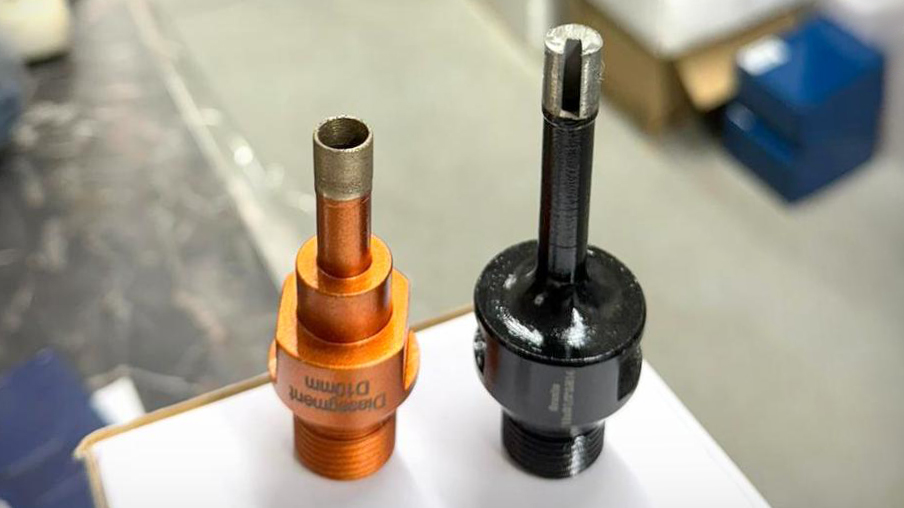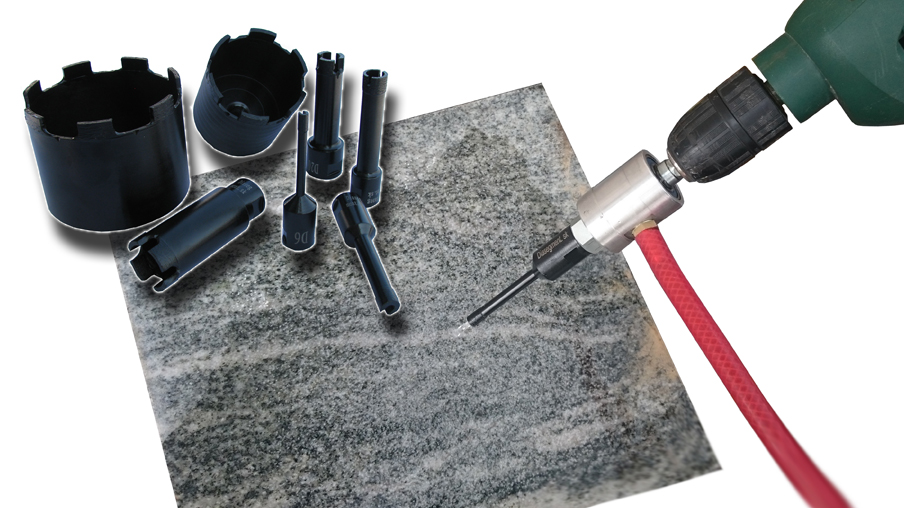Drilling into stone is a demanding process that requires good technical equipment and sufficient knowledge of the material. Whether you are a hobbyist or a professional, only the right procedure will help you achieve perfect and professional results.
It is not a stone like a stone
First of all, it is important to define the material correctly. For example, marble is drilled differently than granite, sandstone or concrete, yet the tools are very similar. The wrong choice of the tool risks a low service life, blunting or its complete destruction. We addressed the issue of how to correctly identify the material in this article.
What are the risks of drilling into rock?
Incorrect technique, overheating, high working pressure, or inappropriate choice of tool can cause damage or cracking of the material. Using coolant and regularly checking the temperature will reduce the risk of overheating.
Basic division of drills according to segment shape:
Choosing between a core and shank drill depends on the specific requirements of your project.
- Shank diamond drills have a solid diamond segment with a hole for water supply. Such a tool is more demanding to be cooled with water from the surrounding area. It is preferred to use water directly from the machine through the body of the drill. The liquid cools and at the same time washes away the ground material from the work surface. Shank drills are mainly used for the smallest diameters. Our offer includes such tools with a diameter of 3, 4, 5, 6, 8, 10 and 12 millimeters.
- Crown diamond drills also called crowns, countersinks or core drills. In principle, they are cutting discs with a horizontally placed diamond segment on a hollow cylinder. They are less demanding to overheat and it is possible to use an external rinse with water (it is not always necessary in the middle of the tool) In our offer you will find such tools with a diameter from 12 millimeters to 200 millimeters
- Vidium rock drills are still the most affordable option. Their advantage is that they are not demanding on cooling or machinery. A big disadvantage is the risk of cracking or breaking off a piece of stone, especially on the edge of the material or on the opposite side of the well (when drilling into a stone plate). This is due to the fact that hammering is almost always used.

Crown and shank diamond drill bit
How to drill a hole correctly and accurately?
A big advantage of drilling with diamond drills is a precise and clean cut. It doesn't seem like it, but it's very simple. We have a trick for that. Drill a hole in another, preferably thin material. For example, in cladding, cuttings or wooden boards. You can attach it exactly to the place where you are going to drill. You have obtained a guide - a guide flange. Now it will go smoothly!
Description: Using a template when drilling with a diamond core drill
Our tip.
Use a thick sandpaper to protect the surface from unwanted scratches during work
How not to overheat a diamond drill?
In general, it is not harmful to use liquid cooling for diamond tools, even those designed for dry work. It is a suitable medium that cools and at the same time washes out the abraded parts of the material. If it is not possible to use liquid cooling, we recommend that you take out the tool at regular intervals and let it cool down during rotation.
How not to do it? It often happens to us that an inexperienced craftsman puts a hot drill bit into water to cool it down. Most likely, the tool is completely destroyed after such "clouding". You have to cool continuously, gradually, patiently...

Photo: Using a water adapter
Is it appropriate to use a hammer?
Certainly not! Diamond drills, core drills, crown drills or ring cutters are basically cutting discs, only with a different direction of movement. During this movement, the diamond segment grinds away the material - stone. This process needs to be properly cooled or overheating eliminated.
Division of diamond drills according to use
- Diamond core drills, also called crowns, are intended for drilling holes mostly with an industrial focus, for example transitions in concrete structures. These tools can drill holes in stone, asphalt, concrete, reinforced concrete and basically all common building materials.
- Diamond drill bits for paving and tiling, i.e. for materials such as ceramics, gres, glass, but also marble. The main feature of such a drill is a clean hole without damage to the surroundings of the hole, i.e. without damage to the surrounding glaze. It is ensured by a pure diamond bond, vacuum applied to the tubular body of the reamer:
- Diamond drill bits for granite and hard stone have a solid sintered diamond segment. If you choose the right working conditions, such as suitable revolutions, cooling and sludge flushing, you can drill approximately 3.5 meters of granite with a drill with a diameter of 35 mm and a segment height of 10 mm. That's a really decent performance. We have this data confirmed by our client for this particular type of drills.
Conclusion
The right choice of diamond crown depends on the specific project you are working with. Each type of tool has its specific parameters and is designed for specific applications. With a suitable choice and the right poby using it, you will achieve perfect, professional results with a long tool life.
